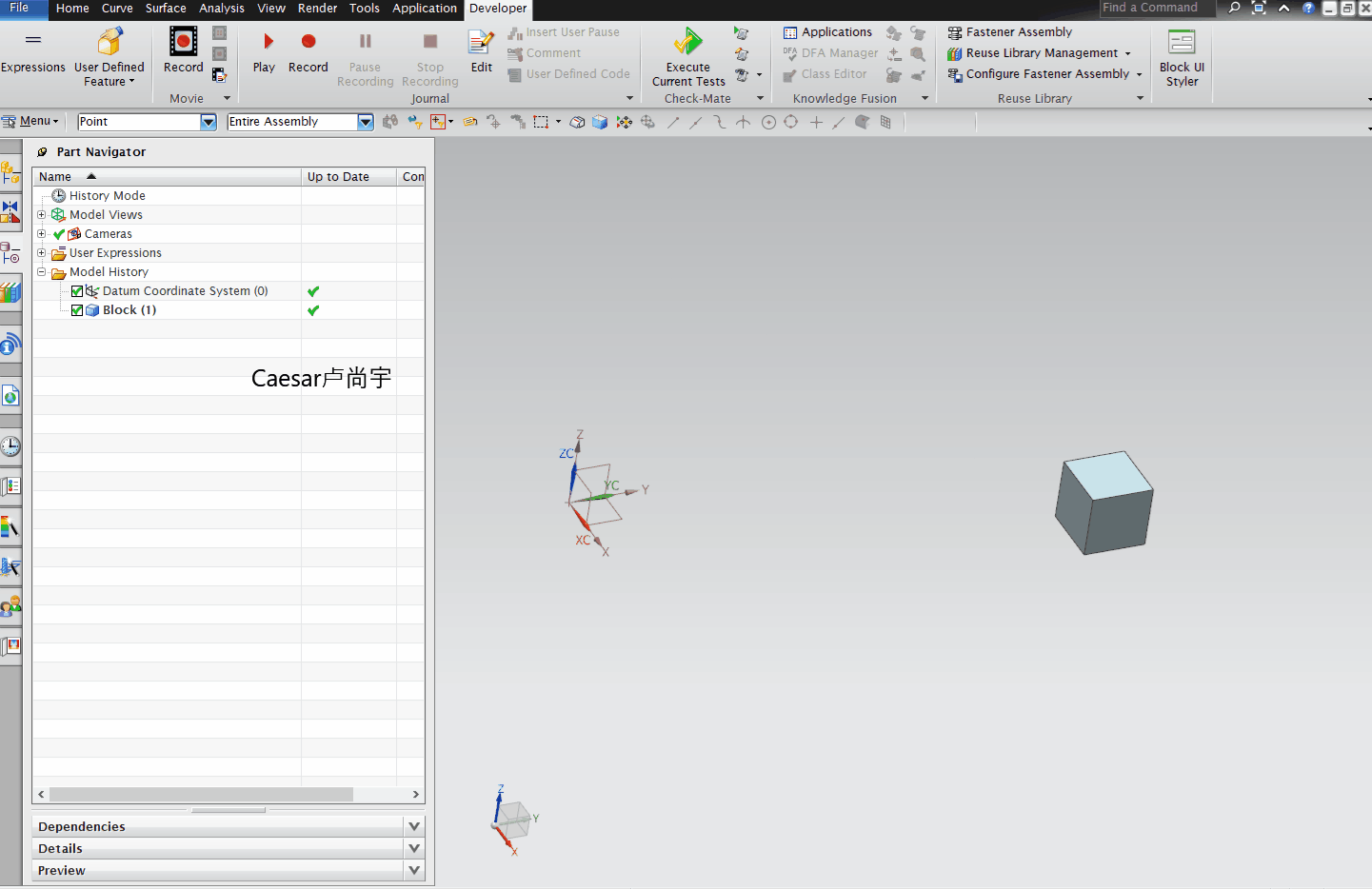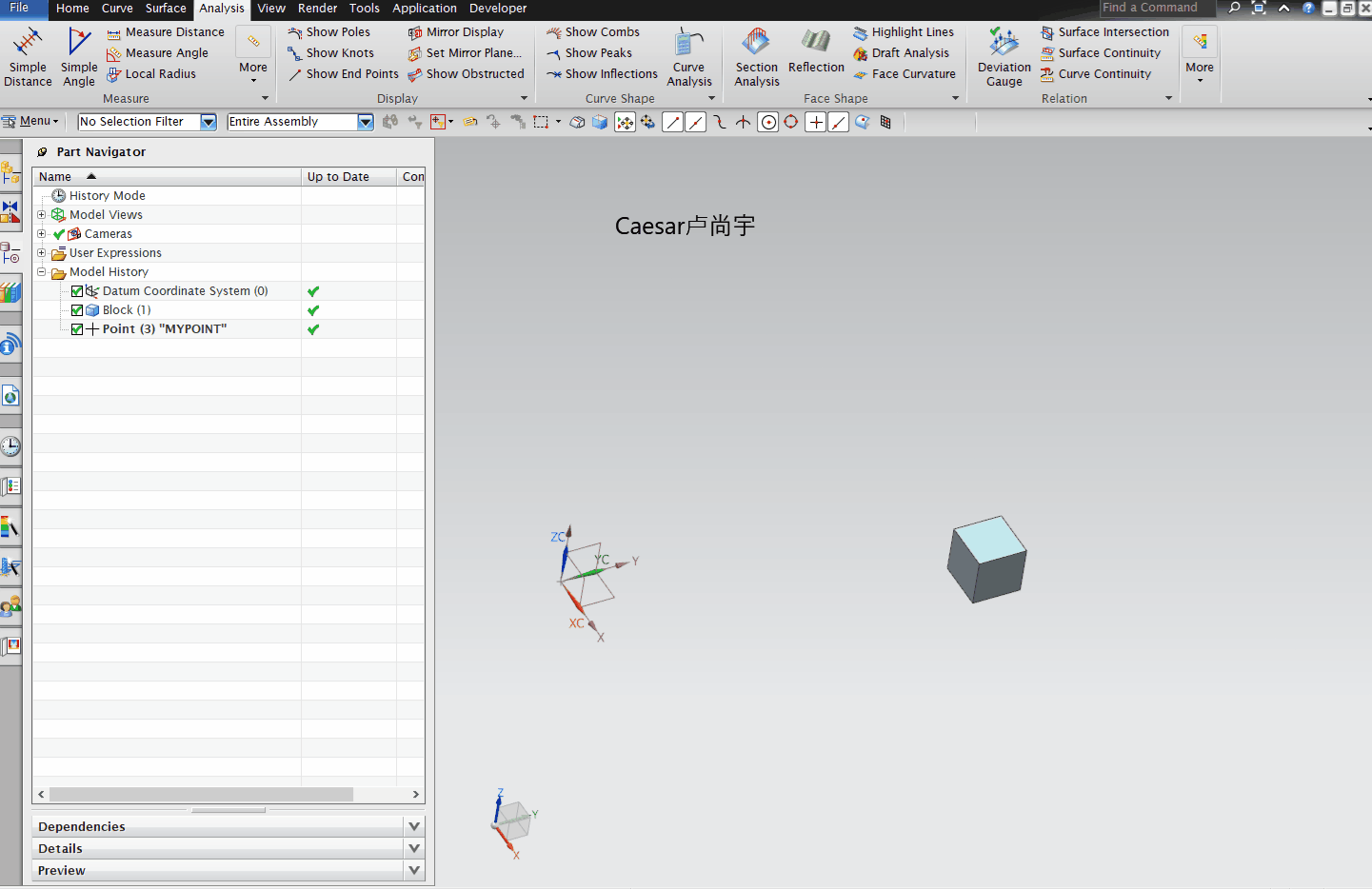NXOPEN方法,直接录制测量投影距离命令
1 NX9+VS2012 2 3 #include <NXOpen/Annotations.hxx> 4 #include <NXOpen/Assemblies_Component.hxx> 5 #include <NXOpen/Assemblies_ComponentAssembly.hxx> 6 #include <NXOpen/Body.hxx> 7 #include <NXOpen/BodyCollection.hxx> 8 #include <NXOpen/Face.hxx> 9 #include <NXOpen/Line.hxx> 10 #include <NXOpen/NXException.hxx> 11 #include <NXOpen/Part.hxx> 12 #include <NXOpen/PartCollection.hxx> 13 #include <NXOpen/DirectionCollection.hxx> 14 #include <NXOpen/MeasureBuilder.hxx> 15 #include <NXOpen/MeasureDistance.hxx> 16 #include <NXOpen/MeasureDistanceBuilder.hxx> 17 #include <NXOpen/MeasureManager.hxx> 18 #include <NXOpen/Point.hxx> 19 #include <NXOpen/PointCollection.hxx> 20 #include <NXOpen/ScCollector.hxx> 21 #include <NXOpen/SelectDisplayableObject.hxx> 22 #include <NXOpen/NXObjectManager.hxx> 23 #include <uf_obj.h> 24 #include <uf_part.h> 25 #include <uf_ui.h> 26 27 28 29 UF_initialize(); 30 31 32 //找名字得到面的tag 33 tag_t FaceTag = NULL_TAG; 34 UF_OBJ_cycle_by_name("MYFACE", &FaceTag); 35 36 //以下为NXOPEN录制 37 NXObject *nullNXObject(NULL); 38 MeasureDistanceBuilder *measureDistanceBuilder1; 39 measureDistanceBuilder1 = workPart->MeasureManager()->CreateMeasureDistanceBuilder(nullNXObject); 40 41 Point3d origin1(0.0, 0.0, 0.0); 42 Vector3d vector1(0.0, 1.0, 0.0);//设置矢量方向 43 Direction *direction1; 44 direction1 = workPart->Directions()->CreateDirection(origin1, vector1, SmartObject::UpdateOptionAfterModeling); 45 46 measureDistanceBuilder1->SetProjectionVector(direction1);//设置投影 47 48 //创建点 49 NXOpen::Point3d Point1XYZ(0,0,0); 50 51 //Point3d转Point 52 NXOpen::Point *Point1 = workPart->Points()->CreatePoint(Point1XYZ); 53 54 //设置第一个对象 55 measureDistanceBuilder1->Object1()->SetValue(Point1); 56 57 //设置第二个对象 58 Face *face1(dynamic_cast<Face *>(NXOpen::NXObjectManager::Get(FaceTag))); 59 measureDistanceBuilder1->Object2()->SetValue(face1); 60 61 //创建,类型为投影距离 62 MeasureDistance *measureDistance1; 63 measureDistance1 = workPart->MeasureManager()->NewDistance(NULL, Point1, face1, direction1, MeasureManager::ProjectionTypeMinimum); 64 65 //获得距离 66 double Distance = measureDistance1->Value(); 67 68 //打印 69 char msg[256]; 70 sprintf_s(msg, "%f", Distance); 71 uc1601(msg, 1); 72 73 //销毁删除 74 delete measureDistance1; 75 76 UF_terminate(); 77 78 Caesar卢尚宇 79 2019年7月26日

UFUN写的算法
思路:自己指定原点和矢量方向,从原点沿着矢量方向作一条无限长的直线,在对选择的面获取面的原点和向量方向,创建一个基准平面(基准平面是无限大的),最后求直线和基准平面的交点到原点距离,就是投影距离。
1 NX9+VS2012 2 3 #include <uf.h> 4 #include <uf_ui.h> 5 #include <uf_csys.h> 6 #include <uf_curve.h> 7 #include <uf_obj.h> 8 #include <uf_mtx.h> 9 #include <uf_modl.h> 10 11 12 13 UF_initialize(); 14 15 //找名字得到点的tag 16 tag_t PointTag = NULL_TAG; 17 UF_OBJ_cycle_by_name("MYPOINT", &PointTag); 18 19 //找名字得到面的tag 20 tag_t FaceTag = NULL_TAG; 21 UF_OBJ_cycle_by_name("MYFACE", &FaceTag); 22 23 //由点出发创建直线 24 25 //创建向量方向 26 double Vec[3] = { 0.0, 0.0, 1.0 }; 27 28 //3*3矩阵,输入Z向量,得到矩阵 29 double Mtx[9]; 30 UF_MTX3_initialize_z(Vec, Mtx); 31 32 //创建矩阵 33 tag_t MatrixTag = NULL_TAG; 34 UF_CSYS_create_matrix(Mtx, &MatrixTag); 35 36 //创建临时坐标系 37 double P1[3] = { 0.0, 0.0, 0.0 };//直线起点 38 tag_t CsysTag = NULL_TAG; 39 UF_CSYS_create_temp_csys(P1, MatrixTag, &CsysTag); 40 41 //设置WCS 42 UF_CSYS_set_wcs(CsysTag); 43 44 //创建直线终点 45 double P2[3] = { P1[0], P1[1] + 10000, P1[2] }; 46 47 //从当前工作坐标系转换到绝对坐标系 48 int InputCsys = UF_CSYS_ROOT_WCS_COORDS; 49 int OutputCsys = UF_CSYS_ROOT_COORDS; 50 double OutputPoint[3]; 51 UF_CSYS_map_point(InputCsys, P2, OutputCsys, OutputPoint); 52 53 //创建直线 54 UF_CURVE_line_t LineCoods; 55 LineCoods.start_point[0] = P1[0]; 56 LineCoods.start_point[1] = P1[1]; 57 LineCoods.start_point[2] = P1[2]; 58 LineCoods.end_point[0] = OutputPoint[0]; 59 LineCoods.end_point[1] = OutputPoint[1]; 60 LineCoods.end_point[2] = OutputPoint[2]; 61 tag_t LineTag = NULL_TAG; 62 UF_CURVE_create_line(&LineCoods, &LineTag); 63 64 //获得面的原点和向量方向 65 int Type; 66 double Point[3]; 67 double Dir[3]; 68 double Box[6]; 69 double Radius[3]; 70 double RadData[3]; 71 int NormDir; 72 UF_MODL_ask_face_data(FaceTag, &Type, Point, Dir, Box, Radius, RadData, &NormDir); 73 74 //创建基准平面 75 tag_t Plane_Tag = NULL_TAG; 76 UF_MODL_create_fixed_dplane(Point, Dir, &Plane_Tag); 77 78 //求直线与基准平面的交点 79 int IntersectionsNum; 80 UF_MODL_intersect_info_p_t * Intersections; 81 UF_MODL_intersect_objects(LineTag, Plane_Tag, 0.01, &IntersectionsNum, &Intersections);//输入两个对象tag,找交点 82 83 double IntersectionsPoint[3];//交点坐标 84 for (int i = 0; i < IntersectionsNum; i++) 85 { 86 int type = Intersections[i]->intersect_type; 87 if (type == UF_MODL_INTERSECT_POINT) 88 { 89 IntersectionsPoint[0] = Intersections[i]->intersect.point.coords[0]; 90 IntersectionsPoint[1] = Intersections[i]->intersect.point.coords[1]; 91 IntersectionsPoint[2] = Intersections[i]->intersect.point.coords[2]; 92 } 93 } 94 95 //删除直线和基准平面 96 UF_OBJ_delete_object(LineTag); 97 UF_OBJ_delete_object(Plane_Tag); 98 99 //打印 100 char msg[256]; 101 sprintf_s(msg, "距离为:%f", IntersectionsPoint[1]); 102 uc1601(msg,1); 103 104 //释放内存 105 UF_free(Intersections); 106 107 UF_terminate(); 108 109 caesar卢尚宇 110 2019年7月26日
